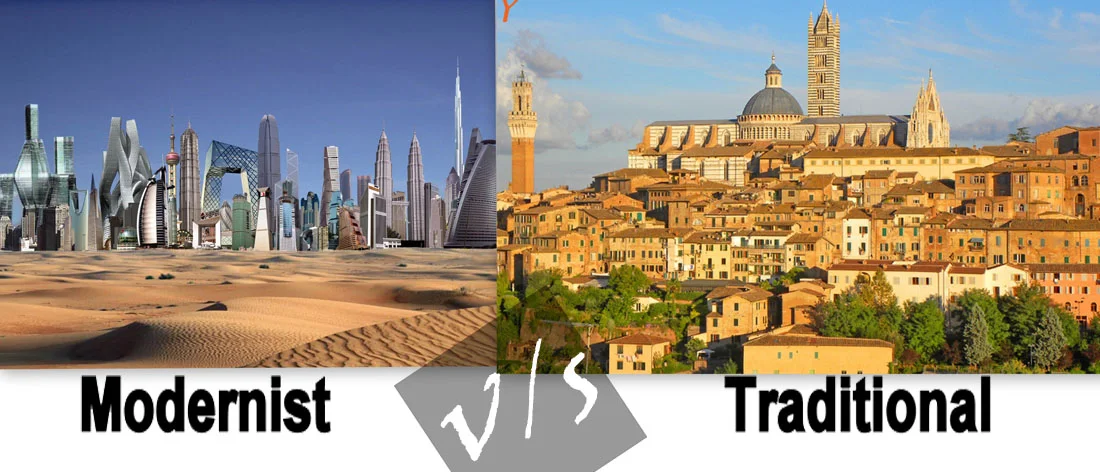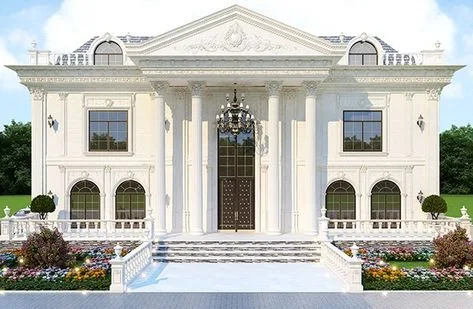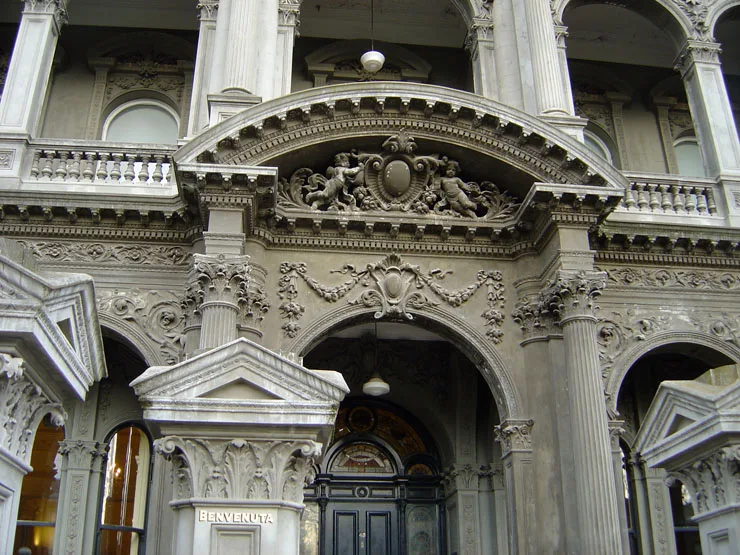The Architectural Old Conflict: Modern or Classic Architecture Styles
The Architectural Dispute Ever: Modern vs. Classic Architecture Styles. Which One to Choose?
In the world of architecture, the debate between modern and contemporary architectural styles on the one hand, and the classic style on the other hand, has been ongoing for centuries. However, each style has its unique characteristics and features, attracting both enthusiasts and critics. But what factors truly influence our decision when it comes to selecting between these two distinctive architectural approaches?
The answer to this is very crucial; In this post today, I'll be talking from my personal point of view. I will be mainly discussing elevations and why clients or homeowners are always confused about which architectural style to adopt: Classic or Modern. So, let's delve into the heart of this debate, exploring 4 main reasons that shape our architectural preferences.
 |
| Img.1- The architectural conflict ever. Photo edited |
Many Reasons Affect the Preference between the Modern and the Classic Styles
Honestly, my inclination leans more toward the modern style rather than the classic in some cases. This preference is rooted in four primary reasons:
- Symmetry
- Ground Floor Constraints
- Abundance of ornaments
- Abundance of Columns and Arches
1- Symmetry: The Age-Old Debate
Symmetry has long been hailed as a hallmark of classical architecture, tracing its roots back to ancient civilizations where balance and proportion were admired. From the Parthenon in Greece to the Taj Mahal in India, symmetrical designs have left a memorable mark on architectural history. (Img.2) But why do humans gravitate towards symmetry?
 |
| Img.2- Ancient civilizations feature a lot of symmetrical buildings. Photo edited. |
The answer lies deep inside our psyche, perhaps engraved since the dawn of creation. Consider the natural world around us, where symmetry is prevalent in the design of living organisms. From the bilateral symmetry of butterflies to the symmetrical patterns on flower petals, nature exhibits a preference for balance and harmony.
However, in the realm of architecture, the allure of symmetry is not without its critics. Modern architects often challenge the notion of rigid symmetry, opting for asymmetrical designs that evoke a sense of dynamism and innovation. Take, for instance, the Sydney Opera House, whose sweeping, irregular forms defy traditional symmetrical conventions yet captivate the imagination.
In practical terms, the constraints of site conditions and functional requirements can also influence the decision to forego symmetry. A sloping terrain or irregularly shaped lot may necessitate asymmetrical design solutions to maximize space utilization and enhance visual interest.
God's Wisdom
On the sidelines of the conversation, let us discuss why symmetry is sometimes needed and sometimes it is not; plus, when we should use it and when we shouldn't. Why do we need symmetry at all? Many questions came to mind that we will try to answer in this article... In nature, God Almighty created creatures that move or are exposed to a whirlwind to be balanced.
So, He created them symmetrical or almost, meaning the moral is clear here, whether the elephant, the ibex, the tiger, or even birds. (Img.3) Birds, in particular, are exposed to strong air resistance. Therefore, to fly balanced, they need to be symmetrical.
 |
| Img.3- By nature, symmetry has existed since the creation age. Photo edited. |
Similarly, what is said about birds applies to animals. Animals instinctively run but what if a part of their body, for example, the right part is heavier or more or less expressive than the left? Running will not be balanced and easy, and they might find it hard to achieve. Insects do the same thing; they fly.
Fish and whales move because they are exposed to the resistance of the water deep down the oceans, so they need to be harmonious and coordinated to swim through... There is no deviation in swimming in the water because the two sides of the body must be symmetrical. So, symmetry is important in creatures that need to be balanced, whether they are standing or running, and the winds come in or across.
So, as you can see, the Symmetry in nature was on purpose, which means that we don't have to use it in our designs unless we need to. As a practical example here, industrial engineers design cars, airplanes, and boats to be 100% symmetrical, as we do not see an asymmetrical airplane or car.
Plants, unlike animals, are stationary beings, rooted in the ground, yet they exhibit a remarkable feature: symmetry. This characteristic is necessary for their survival, particularly when to face environmental factors such as wind and severe weather. Why? When the wind blows, it exerts pressure on the plant, potentially causing damage if the plant is not symmetrical. Wait, I will explain...
Imagine a tree with irregular growth; if the wind hits it, it could lead to bending or even breaking of its stem. This is why many trees tend to display symmetry in their structure, except those with a single main stem like palm trees and others. Another interesting live example here is the mountains; because they are not a moving element in nature, their forms tend to be asymmetrical thanks to God. (Img.4)
 |
| Img.4- Mountains are a great live example showing us the power and wisdom of God's Creation, that every element has its scientific explanation. Photo: worldatlas.com |
In essence, mobile elements, such as parts of vehicles or organisms in motion, benefit from symmetry to minimize air resistance as they move forward. Symmetrical design helps streamline their shape, reducing drag and making them more aerodynamically efficient.
However, stationary or stable elements don't require this symmetry as they aren't subjected to the same forces while at rest. Therefore, they can have more varied or asymmetrical designs without compromising their functionality or stability, such as houses and living spaces.
2- Ground Floor Constraints: Pushing the Boundaries
The second reason that makes me avoid the classic architectural style in general, is the loyalty - if we can say - to a hierarchical structure, where the ground floor serves as a sturdy foundation upon which subsequent floors rest. This structural hierarchy imparts a sense of solidity and permanence to classical buildings, reflecting the ideals of stability and organization.
In fact, architects and designers couldn't execute projects with alteration of volumes and forms due to the absence of reinforced concrete unknown yet at this period. One of the annoying facts about the classic style is that it is difficult to have cantilevers that overcome the ground floor and as a result, create a connectivity between different volumes and proportions.
This matter restricts their capability of creating revolutionary forms and shapes, especially for architects who have been restricted to undergoing the "boxed" concepts for all their projects; That's why we always see lots of useless colonnades or arches, covering the facades in a try to break the monotony always present in the classic style, without any harmonic volume or flexible forms. (Img.5)
 |
| Img.5- Note how the floors are crowded, without any restrictions from each other, unless minimal. Photo: Pinterest |
However, in the realm of modern architecture, the notion of hierarchy is often challenged, with designers exploring innovative ways to blur the boundaries between floors; That is the concept of a "floating" or cantilevered first floor defies traditional notions of structural hierarchy, creating dynamic visual compositions that defy gravity.
For example, Frank Lloyd Wright's Fallingwater seamlessly integrates the natural landscape with architectural form, as the cantilevered terraces appear to float above the cascading waterfall below. This departure from conventional ground-floor constraints not only enhances the aesthetic appeal but also invests the space with a sense of fluidity and movement. It was impossible to apply these architectural concepts to the classical style due to its limitations and constraints that differ from the modern style.
3- Lots of useless Ornaments
The third reason why my preference tends more toward the modern style is that classical architecture is renowned for its ornamental richness, with intricate details decorating facades, columns, and cornices. From the ornate carvings of ancient temples to the elaborate stonework of Renaissance palaces, decoration has been an integral part of classical architectural expression. (Img.6)
 |
| Img.6- Victorian architectural style with various details of ornaments. Photo: melbourneartcritic.wordpress.com |
That's why we were facing facades with lots of ornaments to break down the monotony and to hide the fake and incorrect treatment for many of the problems that were confronting the designers during this time. However, in the modern era, the trend towards minimalism has prompted a reevaluation of the role of ornamentation in architectural design.
Architects like Ludwig Mies van der Rohe championed the mantra "less is more," advocating for a pared-down aesthetic that prioritizes simplicity and clarity. Yet, the debate over ornamentation persists, with some arguing that decorative elements serve not only an aesthetic but also a symbolic function. For example, the intricate arabesques of Islamic architecture not only delight the eye but also convey spiritual meanings and cultural motifs.
Ultimately, the decision to embrace or eschew ornamentation hinges on the desired architectural expression and the cultural context in which it resides. While classical styles may revel in ornamental exuberance, modern designs may opt for a more restrained approach, letting form follow function.
4- Abundance of Columns and Arches
Classical architecture is characterized by its reliance on classical orders, including columns, arches, and pediments, which evoke a sense of grandeur and monumentality. These structural elements not only support the weight of the building but also serve as expressive features that convey a sense of architectural language.
In contrast, modern architecture often favors structural honesty, where the form follows the function without unnecessary embellishments. Architects like Le Corbusier, especially in his project "Villa Savoie" embraced the use of reinforced concrete and steel, eschewing traditional masonry construction in favor of industrial materials.
Yet, the allure of classical structural elements persists in the modern era, as architects seek to imbue their designs with a sense of timeless elegance and sophistication. The incorporation of columns and arches in contemporary buildings pays homage to the rich architectural heritage while offering a fresh reinterpretation for the modern age.
On the other hand, while the arches and columns in the classical style, tend to cover long distances, the modern style by inventing reinforced concrete solved the problem forever. Today, we can cover large areas without the need for excessive use of columns or arches. So, designing using the modern style is now more constraints-free.
Finally, in the complex tapestry of architectural style design, the choice between modern and classic styles is not merely a matter of aesthetic preference but a reflection of broader cultural, historical, and technological forces.
Whether embracing the timeless elegance of classical architecture or the bold expressionism of modern design, architects continue to push the boundaries of creativity and innovation. Ultimately, the beauty of architecture lies in its ability to inspire, provoke, and transcend the constraints of time and space. Also, we should always remember the timelessness of the classical style that still even after decades inspires and enlightens our steps for a new era of innovative architecture.
.png)






